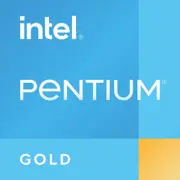Intel Pentium Gold G5420

Intel Pentium Gold G5420: A Budget Processor for Basic Tasks in 2025
Introduction
The Intel Pentium Gold G5420 processor, released in 2019, remains a popular choice for budget builds. Despite its age, it delivers sufficient performance for everyday tasks. In 2025, it can be found for a reduced price (around $50–60), making it attractive for office PCs, media centers, and simple home systems. Let’s explore who this CPU is suitable for and what pitfalls to consider.
Key Specifications: Coffee Lake in Miniature
Architecture and Manufacturing Process
The Pentium Gold G5420 is built on the Coffee Lake architecture with a 14-nanometer manufacturing process. It is a dual-core processor with Hyper-Threading support (4 threads), allowing it to handle multitasking more effectively. The base clock speed is 3.8 GHz with no turbo boost.
Key Features:
- Integrated graphics Intel UHD Graphics 610 — suitable for outputting to 4K monitors and lightweight gaming.
- Supports DDR4-2400 in dual-channel mode.
- Low power consumption (TDP 54 W), which simplifies the choice of cooling system.
Performance:
- In the Geekbench 6 benchmark, the processor scores 764 points in single-threaded mode and 1515 in multi-threaded mode. For comparison, modern Core i3 13th generation processors score 2–3 times higher but are 4–5 times more expensive.
Compatible Motherboards: What to Choose in 2025
Socket and Chipsets
The processor uses the LGA 1151 (v2) socket, compatible with chipsets H310, B360, H370, Z390. By 2025, new motherboards for this socket are no longer produced, but they can be found in stock or on the secondary market.
Recommendations:
- ASUS Prime H310M-K — a simple and reliable motherboard (price around $60–70).
- Gigabyte B360M DS3H — an option with 4 RAM slots and M.2 for SSDs ($70–80).
Important:
- Check the BIOS version — some motherboards require an update to work with the Pentium G5420.
- Avoid Z-series chipsets — their functionality (overclocking) is excessive for this processor.
Memory: DDR4 and Dual-Channel Mode
The Pentium G5420 supports DDR4-2400 in dual-channel configuration. The maximum capacity is 64 GB (officially), but for basic tasks, 8–16 GB is sufficient.
Example Build:
- 2 modules of 4 GB DDR4-2400 — activating dual-channel mode will increase integrated graphics performance by 15–20%.
- For a media center, 8 GB is adequate; for an office PC, 16 GB is advisable if you plan to work with many browser tabs.
DDR5 is not supported — this is a limitation of the Coffee Lake architecture.
Power Supply: Minimal Cost
With a TDP of 54 W, the Pentium G5420 does not require a powerful power supply. Even considering a discrete graphics card like the GTX 1650, a power supply of 400–450 W will suffice.
Recommendations:
- Be Quiet! System Power 10 450W ($45–50) — a quiet and reliable option.
- For systems without a graphics card, a 300 W power supply will do (e.g., FSP Hyper K 300W, $30).
Tip: Don’t skimp on the power supply — cheap models may fail and damage components.
Pros and Cons: Who Should Consider This?
Pros:
- Price — one of the most affordable processors on the market.
- Energy Efficiency — suitable for compact cases.
- Integrated Graphics — no need to purchase a separate graphics card.
Cons:
- 2 cores — a weak point in 2025. Even browsers and office applications actively utilize multithreading.
- Limited Upgrade Path — switching to a more powerful CPU will require a motherboard replacement.
- Outdated Manufacturing Process — 14 nm compared to competitors with 7–10 nm.
Use Cases: Where G5420 is Relevant
1. Office Tasks
- Working with documents, email, video conferencing.
- Example: A system based on G5420 + 8 GB RAM + 256 GB SSD will handle Microsoft Office and 10+ Chrome tabs well.
2. Multimedia
- Watching 4K video (via HDMI 1.4), streaming services.
- Tip: For HDR content, it's better to use an external media player (e.g., NVIDIA Shield), as UHD 610 has limited HDR support.
3. Light Gaming
- CS:GO — 720p, low settings, 40–50 FPS.
- Minecraft — up to 60 FPS at Full HD with optimized settings.
Comparison with Competitors
AMD Ryzen 3 3200G (Price $80–90)
- 4 cores/4 threads, Vega 8 Graphics.
- Better in multitasking and gaming, but more expensive.
Intel Celeron G5905 (Price $40)
- 2 cores/2 threads, UHD 610.
- The Pentium G5420 wins with Hyper-Threading support.
Conclusion: The G5420 is a sweet spot between Celeron and Ryzen 3 for those who prioritize price.
Practical Assembly Tips
1. SSD is a Must — even a budget Kingston A400 (240 GB, $25) will speed up system loading.
2. Don’t Overpay for a Motherboard — H310 with two RAM slots is sufficient.
3. Cooling — the boxed cooler is adequate, but for quiet operation, consider a Deepcool GAMMAXX 400 ($20).
4. Upgrade — if you plan to add a graphics card, choose a power supply with headroom.
Final Verdict: Who Should Choose the Pentium Gold G5420
You should choose this processor if:
- Your budget is limited ($200–300 for the entire build).
- You need a PC for browsing, office work, or media center use.
- There's no requirement for gaming or video editing.
Alternative: If you're willing to spend an extra $50–100, consider the Ryzen 5 5500 or Intel Core i3-12100 — they will provide a performance cushion for the future.
The Pentium G5420 is an example of a "workhorse" that handles basic tasks without unnecessary expenses. In 2025, it remains a niche but still relevant solution.
Basic
CPU Specifications
Memory Specifications
GPU Specifications
Miscellaneous
Benchmarks
Compared to Other CPU
Share in social media
Or Link To Us
<a href="https://cputronic.com/en/cpu/intel-pentium-gold-g5420" target="_blank">Intel Pentium Gold G5420</a>